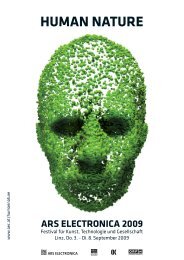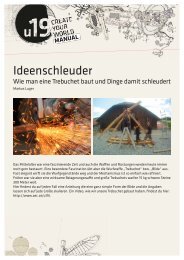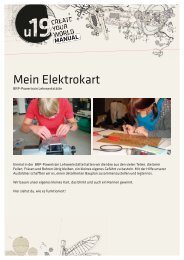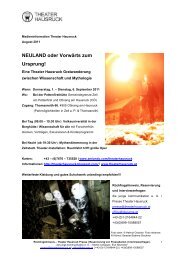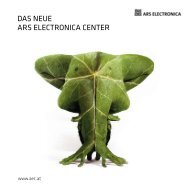festival - Ars Electronica Center
festival - Ars Electronica Center
festival - Ars Electronica Center
Sie wollen auch ein ePaper? Erhöhen Sie die Reichweite Ihrer Titel.
YUMPU macht aus Druck-PDFs automatisch weboptimierte ePaper, die Google liebt.
28<br />
DEEP SPACE LIVE DEEP SPACE LIVE<br />
Vocal-VI<br />
Rúrí (IS)<br />
Do/Thu 30. 8. 18:00 – 18:30<br />
Fr/Fri 31. 8. 17:00 – 17:30<br />
So/Sun 2. 9. 20:30 – 21:00<br />
Island ist reich an spektakulären Regenbögen und Wasserfällen, mit<br />
denen der „mythische“ Charakter der Insel oft und gerne unterstrichen<br />
wird. Genau dieses Bild relativiert die isländische Künstlerin Rúrí mit ihrer<br />
um 2000 begonnenen Werkreihe Archive – Endangered Waters. Denn mit<br />
dieser führt sie der Weltöffentlichkeit die Vernichtung eben dieser Wasserfälle<br />
durch überdimensionierte Kraftwerkprojekte vor Augen. Archive<br />
zeigt in Gestalt multimedialer Installationen akustische und bildliche<br />
Porträts bedrohter isländischer Wasserfälle. Auch die eigens für den Deep<br />
Space konzipierte Videoperformance Vocal-VI widmet sich den bedrohten<br />
Wässern. In ihrer charakteristischen Handschrift stellt die Künstlerin der<br />
gewaltigen Kraft des Wassers eine formale Fragilität entgegen, mit der sie<br />
die Verletzbarkeit des Wasserhaushalts unterstreicht.<br />
Iceland is rich in spectacular rainbows and waterfalls, which are often and<br />
willingly used to underscore the island’s “mythic” character. But it’s precisely<br />
this image that Icelandic artist Rúrí strives to relativize in “Archive – Endangered<br />
Waters,” a series of works she began in 2000. With it, she seeks to call<br />
to the international public’s attention the destruction of these very waterfalls by<br />
massive hydroelectric projects. “Archive” consists of multimedia installations<br />
that display acoustic and visual portraits of Iceland’s endangered waterfalls.<br />
These threatened waters are also the subject of “Vocal-VI,” a video performance<br />
created especially for Deep Space. In her inimitable style, the artist juxtaposes<br />
the water’s violent force to a formal fragility in order to bring out the<br />
vulnerability of the environment’s hydrologic balance.<br />
Photo: María Rún Jóhannsdóttir<br />
Codeform<br />
Jon McCormack (AU)<br />
Do/Thu 30. 8. 18:30 – 19:00<br />
Fr/Fri 31. 8. 13:00 – 13:30<br />
Mo/Mon 3. 9. 12:30 – 13:00<br />
Man muss nicht Gott sein, um Leben zu schaffen – im Deep Space genügt<br />
dazu bereits eine ganz gewöhnliche Eintrittskarte. Codeform, von Jon Mc-<br />
Cormack (AU) so wie auch die im Foyer gezeigte Arbeit Fifty Sisters (siehe<br />
Seite 45) als Artist-in-Residence im <strong>Ars</strong> <strong>Electronica</strong> Futurelab geschaffen,<br />
verwandelt einen beliebigen QR-Code in ein künstliches Lebewesen. Der<br />
Ticketcode wird an Ort und Stelle eingescannt und dient als digitales Gen.<br />
Der Deep Space wird zum Ökosystem, in dem aus dem Code ein Ei mit Embryo<br />
wird. Der wächst, gedeiht, beginnt sich zu regen. Bald darauf wagt er<br />
sich in die 3-D-Welt des Deep Space hinaus, die er gemeinsam mit anderen<br />
Codeform-Kreaturen ergründet. Die Lebensdauer der künstlichen Wesen ist<br />
unterschiedlich lang: Manche sterben nach kurzer Zeit, andere überdauern<br />
in ständiger Weiterentwicklung bis zur nächsten Vorführung. Die BesucherInnen<br />
können wiederholt in den Deep Space zurückkehren<br />
und mit ihrem Ticket prüfen, was aus „ihrem“ Wesen zwischenzeitlich<br />
geworden ist. Codeform wird nach dem Festival in das Jahresprogramm des<br />
<strong>Ars</strong> <strong>Electronica</strong> <strong>Center</strong> übernommen.<br />
You don’t have to be God to create life. In Deep Space, all it takes is a regular<br />
admission ticket. “Codeform” is a work by Jon McCormack (AU) who, during<br />
his stint as artist-in-residence at the <strong>Ars</strong> <strong>Electronica</strong> Futurelab, also created<br />
“Fifty Sisters” (see page 45) that’s on display in the Lobby. “Codeform”<br />
transforms any QR code into an artificial life form. A ticket code is scanned<br />
in on site and serves as a digital gene. Deep Space becomes an ecosystem in<br />
which the code morphs into an egg and then an embryo. It grows, matures,<br />
and begins to move. Soon, it ventures forth into the 3D world of Deep Space,<br />
which it explores together with other Codeform creatures. Their lifespan varies<br />
—some creatures die after a short time; others undergo steady development<br />
and survive to be part of the next performance. Visitors can return to Deep<br />
Space repeatedly and use their ticket to check out what’s become of “their”<br />
creature. After the <strong>festival</strong>, “Codeform” will be an ongoing feature at the<br />
<strong>Ars</strong> <strong>Electronica</strong> <strong>Center</strong>.<br />
u19 Ceremony<br />
siehe Seite/see page 74<br />
Brain Sculpturing<br />
Adi Hoesle (DE), Andrea Kübler (DE), Lars Schwabe (DE)<br />
Fr/Fri 31. 8. 14:30<br />
Mo/Mon 3. 9. 16:00<br />
Am Computer Bilder zu malen, ohne dabei die Hände, Tastatur oder Maus<br />
einzusetzen: Brain Painting macht es durch ein Brain-Computer-Interface<br />
(BCI) und spezielle Software möglich (siehe Seite 46). Adi Hoesle (DE)<br />
demonstriert in den Brain-Painting-Sessions im Deep Space, wie durch<br />
bewusste Gehirnaktivität Bilder entstehen.<br />
Paint pictures at a computer without the use of your hands, keyboard or<br />
mouse. Brain Painting lets you produce images via a brain-computer interface<br />
(BCI) and special software (see page 46). In the Brain Painting sessions<br />
in Deep Space, Adi Hoesle (DE) will demonstrate how images result from<br />
conscious brain activity.<br />
Reaching Out Into The Deep Universe<br />
Warren Keller (US)<br />
Fr/Fri 31. 8. 18:00<br />
Sa/Sat 1. 9. 14:00<br />
Mo/Mon 3. 9. 13:00<br />
Als einer der Top-Ten-Astrofotografen der USA weiß Warren Keller wie kein<br />
Zweiter über die Filter im Bildbearbeitungsprogramm Photoshop Bescheid<br />
– hat er sie doch zum Teil selbst entwickelt. Ebenso umfassend ist sein<br />
Wissen über die Geschichte der sogenannten Deep-Sky-Astrofotografie,<br />
die Bilder aus den ganz entfernten Weiten des Universums liefert. In seiner<br />
Deep-Space-Session zeigt der erfolgreiche ehemalige Musiker und Songwriter,<br />
wie Deep-Space-FotografInnen arbeiten und wie auch AmateurInnen<br />
Bilder gelingen, die sich spielend mit jenen des Hubble Space Telescope<br />
messen können.<br />
Warren Keller is one of the USA’s top astrophotographers, and his skill in using<br />
filters in Adobe’s Photoshop graphics editing program is unsurpassed—after all,<br />
he developed some of them himself! Keller also possesses comprehensive<br />
knowledge about the history of deep-sky astrophotography that captures<br />
images from distant realms of the cosmos. In his Deep Space session, the<br />
successful former musician and songwriter will demonstrate how deep-sky<br />
photographers work and how even amateurs can take pictures that can hold<br />
their own against those shot by the Hubble Space Telescope.<br />
Weltbilder in der Astronomie<br />
Dietmar Hager (AT)<br />
Fr/Fri 31. 8. 19:00<br />
Sa/Sat 1. 9. 12:30<br />
Mo/Mon 3. 9. 14:00<br />
Mit Deep-Space-Kurator Dietmar Hager (AT), seines Zeichens u. a. Fellow<br />
of the Royal Astronomical Society, geht es auf Zeitreise durch die menschliche<br />
Kulturgeschichte der Kontinente. Der Astronom und Astrofotograf<br />
erklärt, warum sich der Mensch schon immer an den Sternen orientiert hat<br />
und wie der Sternenhimmel bis heute Impulsgeber für die Entwicklung<br />
von Weltbildern gewesen ist. Eine spannende Rückschau lässt verstehen,<br />
welche Hürden es auf dem Weg von archaischen Auffassungen zu den<br />
Perspektiven der Gegenwart zu überwinden galt – und welche Opfer dafür<br />
gebracht wurden.<br />
Deep Space curator Dietmar Hager (AT), astronomer, astrophotographer and<br />
Fellow of the Royal Astronomical Society, invites you on an astronomical<br />
excursion through human cultural history. He’ll explain why humankind has<br />
been oriented on the stars since time immemorial, and how the starry night<br />
sky has always been a prime determinant in how human beings picture the<br />
world. A fascinating look back in history enables us to comprehend which<br />
impediments had to be surmounted on our path from archaic views to the<br />
way we see things now—and what sacrifices had to be made to achieve this.<br />
Photo: © Dietmar Hager<br />
29



